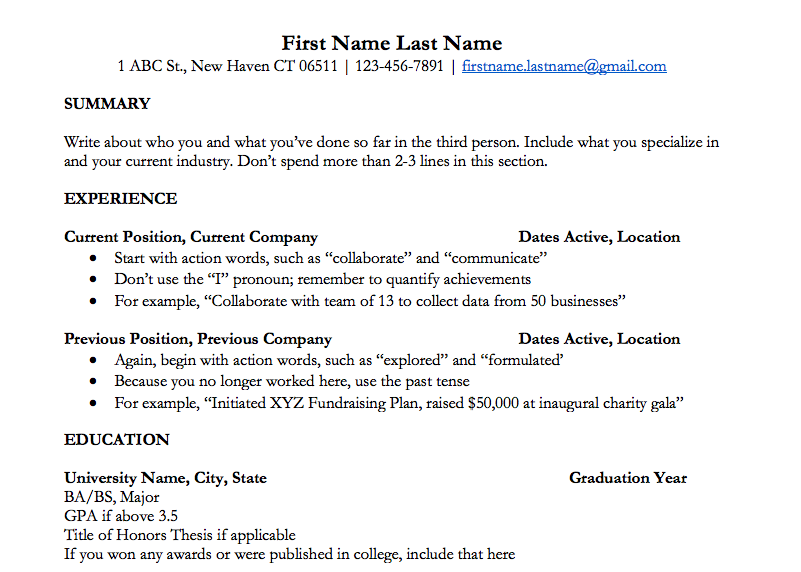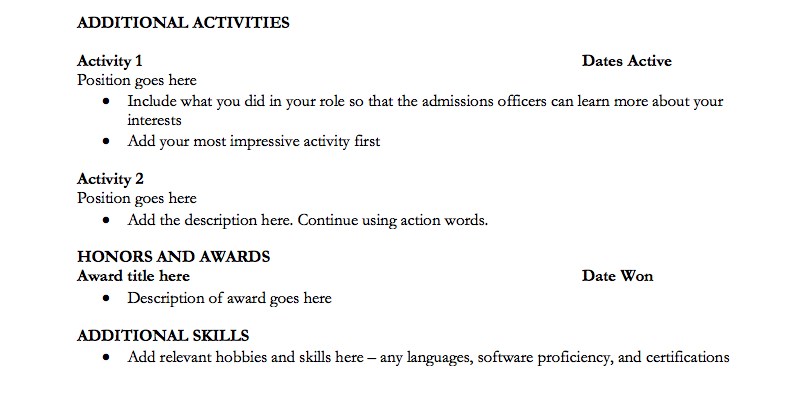
MBA Resumé Dos and Don’ts
December 2, 2019
MBA Resumé Dos and Don’ts
I’m sure you already know that work experience is a key component at almost every top business school. So, it should come as no surprise that your MBA resumé is important, as it conveys the work you’ve done so far to the admissions committee members so that they can determine your fit as a candidate for their institution. While you might already have a resumé from applying to jobs, you will probably have to tweak certain aspects and follow a particular protocol when it comes to preparing the document for business school applications. Here are some dos and don’ts to help you create, edit, and format your MBA resumé.
Dos for Creating Your MBA Resumé
Do Format Correctly
The first thing an admissions officer will notice about your MBA resumé is whether you’ve correctly formatted it or not. Unless you’ve been out of college for 10 years, your resumé should be one page only (see how CMU Tepper lists it), as this is what adcoms prefer. The document should be created with adequate white space (0.75 - 1.0” margins). Remember to use consistent formatting (e.g., bold, italics, underline) throughout the file, when writing out your job titles, company names, dates, etc. The font should be a standard font, such as Times New Roman, and the size should be between 10 and 12.
The resumé must be easy to read. Adding enough spaces and using a legible font size will allow the reader to have a visual break when evaluating the file. You don’t want them to have to squint their eyes when reading your document! Another point to remember when saving the file is to create a PDF version of the resumé to ensure that formatting errors do not occur when transmitting the file electronically.
Do Quantify Your Achievements
MBA admissions committees want to know more about how you have thrived in a business setting. As a result, it’s more important than ever to quantify all that you’ve achieved so far. Think about your career over the years and try to find the most standout numbers. If you’ve led a team in a project, how many members were you in charge of? If you were in sales, how much revenue did you help the company earn? If you’ve been involved in social media, how many people did you help your company reach?
One of the biggest things that MBA candidates struggle with is that their work experiences sound the same as everyone else’s on paper. Quantifiable achievements can help make your experiences sound more special! When creating your MBA resumé, it’s essential to incorporate data that will set you apart, as these facts are eye catching and will help the admissions committee members easily understand your impact.
Do Think Deliberately About the Order of Your Experiences
Admissions officers have an unspoken set of rules when it comes to your MBA resumé. Business schools usually expect that you add a summary of your qualifications as the first thing on your document after your name and contact information. This summary should be concise, and instead of focusing on your goals or purpose, highlight everything you’ve achieved so far. It can include the following:
- A brief look at your career record - Which industries have you worked in? How many promotions have you received?
- Career achievements - What projects have you led? Have you won any awards?
- Experiences that can help you succeed at the MBA program - How has your past prepared you for your time in business school?
The summary should be followed by your work experience. Employment history is absolutely crucial when it comes to applying to business school. The top business schools typically expect candidates to have approximately 3-5 years of work experience before applying - so you need to outline how you’ve spent your time after college. You should dedicate the most amount of space to your current role. Since you have to keep the entire document to one page, add your biggest highlights, and don’t go over four bullet points per position. If you’ve recently started your most recent position, emphasize the most impressive achievements from your previous job.
When writing bullets for each role, the first point should always discuss your leadership roles. Business schools want to help students who have challenged and established themselves as strong leaders. So, if you’ve created an app or led a department, your resumé should bring attention to that.
If you’ve been in the workforce for more than two years, your education should go after your work experience. Don’t spend too many lines on this - mention the school name, your major and GPA, the year of graduation, and if relevant, any publications or thesis projects that you completed. Again, your work experience is the most essential component and the part you should feature the most!
Do Add Activities, Hobbies, and Skills
You might be wondering what to do with the remaining space once you’ve mentioned your educational background. Admissions officers want to know that you have more in life than just focused your firm position. If you’re wondering whether to include extracurricular achievements or activities that you participated in college, the answer is yes, especially if you held leadership position or were involved in an uncommon activity. These can actually help you stand out as a memorable candidate. Your experience being a chef or state champion athlete not only adds more color to your application, but can bring something unique to the table!
You can also add any hobbies that you think could be relevant in business school, such as picking up new coding skills or certain software. If you speak multiple languages, they can help you in a business setting, so don’t be shy to include them!
Do Include Dates
Every time you add something new, make sure that you’ve specified when you were involved with the job or extracurricular. Each of your positions should be followed up with the dates that you were with the particular institution. This helps admissions officers understand the duration of your experience along with your commitment levels at different jobs. If there is a gap in your MBA resumé, you might have to address it at your interview.
Do Think About Wording
Next, it’s time to think about how you word each entry into your MBA resumé. Each of your bullets should start with action verbs. Admissions officers will be able to concretely understand what you did at your role if you use strong verbs. Describing your actions as “conceptualized” or “presented” goes a long way rather than saying you “did” or “worked” on a project or team.
Your wording must also be as specific as possible. Dig into what you really do as part of your role, instead of using vague words such as “participate in” and “contribute to.” You’re trying to stand out as a leader. Not specifying your exact tasks might lead to admissions officers thinking you merely played a supporting part in a project that you actually might have spearheaded.
You will also raise eyebrows if you haven’t used the right tense. Your roles should be described in the past if you’re no longer involved in the organization, and in the present tense for a current job. Be consistent with your wording as well. Don’t say “Led a team of 5” in one bullet and “I was in charge of Project X” in the next. In fact, you should start each point with the verb itself, rather than using any pronouns.
Do Proofread
Once you’ve drafted your MBA resumé fully, remember that the task is not complete. When you type fast and include a lot of information, you are easily prone to making typos or grammatical errors. Business school admissions officers will not appreciate finding misspelled words or grammatical errors as they go through your file. Don’t count on spell check to find your mistakes either - ask a friend or family member to take a look once you’ve proofread it, in case they encounter any errors that you might have missed.
Don’ts for Creating Your MBA Resumé
Don’t Include Feats from High School
While your college education information and relevant activities are more than welcome, avoid adding any information that pertains to what you did in high school. You might have founded a nonprofit when you were in 11th grade, but if you haven’t been involved with it over the last three years, leave it in the past. Unless you won a very important award or had an exceptional achievement that still continues to affect you, it doesn’t belong on your MBA resumé.
Don’t Use Industry Jargon
Your MBA resumé is not the space to show off all of the technical language that you might have picked up during your time at work. As part of making sure your document is easy to read, you have to think about what would be comprehensible to someone who hasn’t been a part of your field. For example, if you’ve worked in consulting but the admissions committee member hasn’t, they’re not as likely to recognize industry-specific terms such as “over-rotate” or “parking lot.” Rather, you might come across to them as pretentious, so avoid jargon and describe your achievements using recognizable terms.
Don’t Exaggerate
It can be tempting to make yourself look as impressive as you possibly can when writing your MBA resumé. And while you shouldn’t be modest and undersell, you shouldn’t misrepresent yourself either and exaggerate your achievements. Don’t say you manage a team of 20 people if you actually manage 10. Or, if your GPA is 3.46, don’t round it to 3.5. Business schools will see your transcript and know what your GPA is, and it’ll reflect badly on your part. You should stay honest at all times.
Don’t Add Unrelated Skills
Remember that the space you get on your MBA resumé is limited. Don’t waste space adding things such as “Proficient in MS Word” or “Fluent in English” because usually these skills are a given if you’re applying to business school in the US. When thinking about what you shouldn’t include, ask yourself the following questions:
- Is this skill or experience important to who you are?
- Is it relevant to the program you’re applying to?
- Will it help you stand out among the competition?
If the answer to any of these is “no,” it doesn’t belong here. Make sure everything you’ve included adds something new to your profile, and helps the admissions officers get to know you better.
Keeping the above dos and don’ts in mind, let’s take a look at a sample MBA resumé to help you get a clearer picture of the document that admissions officers want to see.


Contact Information
Always include a phone number and email address where the admissions office can best reach you. While a physical address might be used to send materials once you’ve been admitted, your phone and emails will be the main point of communication with representatives from the programs of your choice. Note how the email address is a combination of the candidate’s first name and last name. If you’re still using “[email protected],” it’s time to switch to a new Gmail account. You don’t want to come across as unprofessional or childish.
Order
Note how the example begins with a summary, followed by experiences, then education, then activities, and finally awards and skills. Depending on how much space you have, you may or may not add a line between sections, but maintain the same hierarchy at all times.
Work Experience
This is arguably the most important part of your MBA resumé. Make your position title absolutely clear. Don’t just say “Employee” or anything that’s similarly baseline. If your role didn’t have a title, create one that accurately describes what you did. Remember to emphasize leadership positions and standout achievements with the use of action words. Don’t forget that each of your descriptions should start with the verbs, as opposed to opening each point with “I.”
Education
Add the school where you earned your bachelor’s degree. Note how the information is very straightforward and doesn’t take up more space than necessary. You should only add your GPA if it’s above 3.5. If your major GPA is significantly better than your regular GPA, add it. Business schools will already see your GPA, so it’s up to you whether or not you want to keep it in the resumé or not.
Activities
This section helps the adcom determine how you will contribute to the campus community. Schools don’t want every applicant to bring the same background. Take advantage of this section to highlight any leadership roles and unique opportunities that can help you stand out as a memorable applicant.
Honors and Awards
If you have space and if you’ve won any awards within the last five years, include an honors section. It’s always interesting for admissions committee members to see areas where you’ve succeeded. But this section isn’t mandatory, so don’t stress about it if you don’t know what to discuss here.
Additional Skills
This last section is where you add anything you feel like you weren’t able to elsewhere. This could include “Three-time state baking champion,” or “3 years of experience in competitive hip-hop dancing.” These skills could be related to your interest within business or bring out a side of you that admissions officers might not be able to guess at first glance.
Take advantage of the MBA resumé component to convince admissions officers why you are an outstanding candidate. Use this document to bring attention to your most impressive achievements in the workforce along with any other experiences and knowledge that can help distinguish you. Follow our dos, stray away from the don’ts, and edit as much as possible!
General FAQ
Your resumé must be easy to read. Add enough spaces (0.75 - 1.0” margins) and use a legible font such as Times New Roman (font size between 10 and 12). Remember to use consistent formatting (bold, italics, underline) throughout the file when writing your job titles, company names, dates, etc.
Under your name and contact information should be a summary of your qualifications including a brief look at your career record, your achievements, and any experiences that will help you succeed in an MBA program. Next, list your work experience. If you’ve been in the workforce for more than 2 years, list your education after your work experience. Then list your activities, honors and awards, and any additional skills.
Yes! These activities can help you stand out as a memorable candidate, especially if you held a leadership position or were involved in an activity that is uncommon. You should also be sure to add any hobbies that may be relevant in business school such as picking up a coding skill or studying multiple languages. How should I format my MBA resumé?
In what order should I list my achievements?
Should I add my hobbies and activities?
Schedule a free consultation
to find out how we can help you get accepted.


